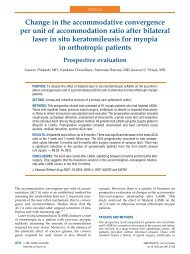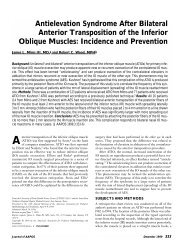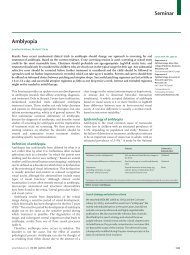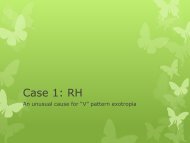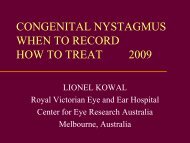What's new AAPOS 2008 - The Private Eye Clinic
What's new AAPOS 2008 - The Private Eye Clinic
What's new AAPOS 2008 - The Private Eye Clinic
You also want an ePaper? Increase the reach of your titles
YUMPU automatically turns print PDFs into web optimized ePapers that Google loves.
deviation as an intermittent exodeviation of 1 eye results from the superimposition of a<br />
dissociated esotonus on a baseline exodeviation.<br />
Variability of Control in Intermittent Exotropia<br />
Ophthalmology <strong>2008</strong>;115:371-376.<br />
Purpose: To assess the presence and degree of any change in control occurring over<br />
the course of day using a previously described 6-point clinical control scale.<br />
Design: A prospective case series of 25 patients with intermittent exotropia. Variability<br />
over 1 day was assessed comparing 3 or 4 assessments at least 2 hours apart.<br />
Results: Interobserver agreement was high. Change in control was defined as ≥2<br />
levels. Twenty-four percent of patients tested twice within 5 minutes showed change in<br />
control. Of the 13 patients assessed over 1 day, 6 (46%), showed change in control.<br />
Conclusions: Control can vary throughout the day including phoric to tropic and vice<br />
versa. <strong>The</strong> worst level of control was not always later in the day.<br />
Reviewer’s Comments: A single assessment of control can not be relied upon to<br />
represent severity in an individual patient. Apparent worsening may in fact represent<br />
normal variability of control in intermittent exotropia.<br />
Comparing Methods of Quantifying Diplopia<br />
Sarah R. Hatt, David A. Leske, Jonathan M. Holmes<br />
Ophthalmology 2007;114:2316-2322<br />
Purpose: Quantification of diplopia is important for describing severity of strabismus,<br />
measuring change over time, and reporting surgical outcomes. <strong>The</strong> cervical range of<br />
motion (CROM) method has been proposed as a simple, inexpensive alternative to the<br />
Goldmann perimeter for quantifying diplopia. Purpose of this study was to compare<br />
these 2 techniques.<br />
Methods: Seventy-six consecutive patients underwent diplopia assessment with the<br />
CROM method and Goldmann perimeter. Where CROM and Goldmann results were<br />
disparate, the medical record was reviewed independently by 2 clinicians.<br />
Results: Overall agreement between the 2 tests was good. <strong>The</strong> most frequent reason<br />
for worse diplopia using the Goldmann technique was poor ability to fuse or suppress<br />
compared with the real-world targets used in free space for the CROM method. Worse<br />
diplopia using the CROM method most often was the results of the deviation being<br />
present for distance only.<br />
Conclusions: In most cases, both provide equivalent measures of diplopia severity.<br />
<strong>The</strong> Goldmann method seems to overestimate diplopia in patients with fragile fusion or<br />
tenuous suppression. <strong>The</strong> CROM method maybe more representative of diplopia<br />
severity as experienced in every day life.<br />
15



